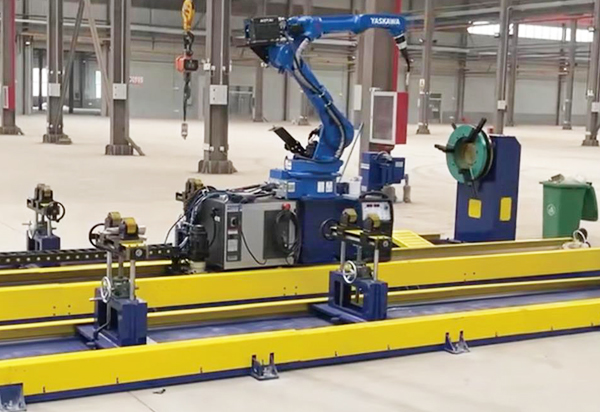Product name:Robot guide rail
Category:Robot guide rail
Release time:2024-11-28
Number of views:61
Product Introduction
Introduction to Robot Welding Guide Rail Project

一、Project background
With the continuous development of industrial automation, the application of robots in the field of welding is becoming increasingly widespread. As an important component of the robot welding system, the robot welding guide rail plays a crucial role in improving welding efficiency, ensuring welding quality, and expanding the scope of welding operations.
二、Project objectives
Improve welding accuracy
By precise guide rail design and manufacturing, it ensures that the robot can perform precise welding according to the preset trajectory during the welding process. For example, the positioning accuracy of the guide rail can be controlled at the millimeter level, making the position error of the welding point extremely small, thereby improving the welding quality and meeting the high-precision welding requirements of industries such as aerospace and precision instrument manufacturing23。
Improve welding efficiency
The guide rail can enable the robot to quickly move to different welding positions, reducing the robot's idle travel time. For example, designing reasonable guide rail speed and acceleration parameters can enable robots to quickly switch between multiple welding tasks. Compared to traditional fixed position welding robots, it significantly increases the welding workload per unit time and reduces production costs23。
Enhance flexibility and adaptability
Adapt to different welding scenarios and workpiece shapes. For example, adjustable guide rail structures can be designed to adjust the working range and posture of robots according to different welding tasks. Whether it is welding large structural components or welding complex shaped workpieces, robot welding guide rail projects can provide suitable solutions and improve the versatility of robot welding systems3。
三、Main content of the project
(一)Guide rail design
Structure Design
Design the structural form of the guide rail according to the welding task requirements, such as linear guide rail, curved guide rail, or composite guide rail. For example, in the production line of automobile body welding, a combination of linear and curved guide rails may be used to meet the welding needs of different parts of the body. At the same time, the bearing capacity of the guide rail should be considered to ensure that it can support the weight of the robot and its ancillary equipment, and maintain stability during high-speed movement3。
Precision design
Determine key accuracy indicators such as positioning accuracy and repeat positioning accuracy of the guide rail. This needs to take into account the precision requirements of the welding process, for example, when welding small components, the positioning accuracy of the guide rail may be required to be within ± 0.1mm. By adopting high-precision manufacturing processes and precise measuring equipment, the accuracy of the guide rail is ensured to meet the design requirements3。
(二)Rail manufacturing
Material selection
Choose suitable guide rail materials, such as high-strength aluminum alloy, steel, etc. Aluminum alloy guide rails have the advantages of light weight and corrosion resistance, making them suitable for welding applications in lightweight robots; Steel guide rails have higher strength and rigidity, making them suitable for welding operations of large and heavy robots. The selection of materials should comprehensively consider factors such as cost, performance, and service life3。
Manufacturing process
Adopting advanced manufacturing techniques such as precision machining, CNC machining, etc. During the manufacturing process, it is necessary to strictly control the machining dimensions and surface quality to ensure that the straightness, flatness, and other indicators of the guide rail meet the requirements. For example, by using a CNC milling machine to process guide rails, the machining dimensions can be precisely controlled, improving manufacturing accuracy3。
(三)Integration of robots and guide rails
Interface design
Design the connection interface between the robot and the guide rail to ensure stable and reliable connection. The design of the interface should take into account factors such as the model, size, and motion mode of the robot, to achieve seamless docking between the robot and the guide rail, ensuring that the robot can move and work smoothly on the guide rail3。
Control system integration
Integrate the control system of the robot with the control system of the guide rail. Realize collaborative control of robots and guide rails through a unified control interface. For example, operators can simultaneously set the welding parameters of the robot and the motion parameters of the guide rail on one console, allowing the robot to automatically run on the guide rail according to the predetermined welding path, improving the automation and efficiency of welding operations3。
五、Project results
Product achievements
A complete robot welding guide rail system, including well-designed and well manufactured guide rails, as well as a control system perfectly integrated with the robot. This system has the characteristics of high precision, high speed, and high reliability, which can meet the needs of different industries and welding tasks.
technological achievements
We have achieved a series of technological achievements in guide rail design, manufacturing, and robot integration, such as innovative guide rail structure design, high-precision manufacturing processes, and advanced control system integration technology. These technological achievements can provide technical support and reference for the development of robot welding field.
economic benefits
Improve welding production efficiency, reduce production costs, and bring significant economic benefits to enterprises. For example, by improving welding efficiency, the production cycle of products can be shortened and the production capacity of enterprises can be increased; By reducing the welding defect rate, the scrap rate can be reduced, product quality can be improved, and the market competitiveness of the enterprise can be enhanced.
social benefit
- Promote the development and application of robot welding technology, and enhance the level of industrial automation. This will help improve the overall competitiveness of China's manufacturing industry, reduce the labor intensity and safety risks caused by manual welding, and create more employment opportunities for society (for example, with the promotion of robot welding technology, more job positions related to robot maintenance, programming, etc. will be created).
- Previous article:Robot guide rail
- Next article:





